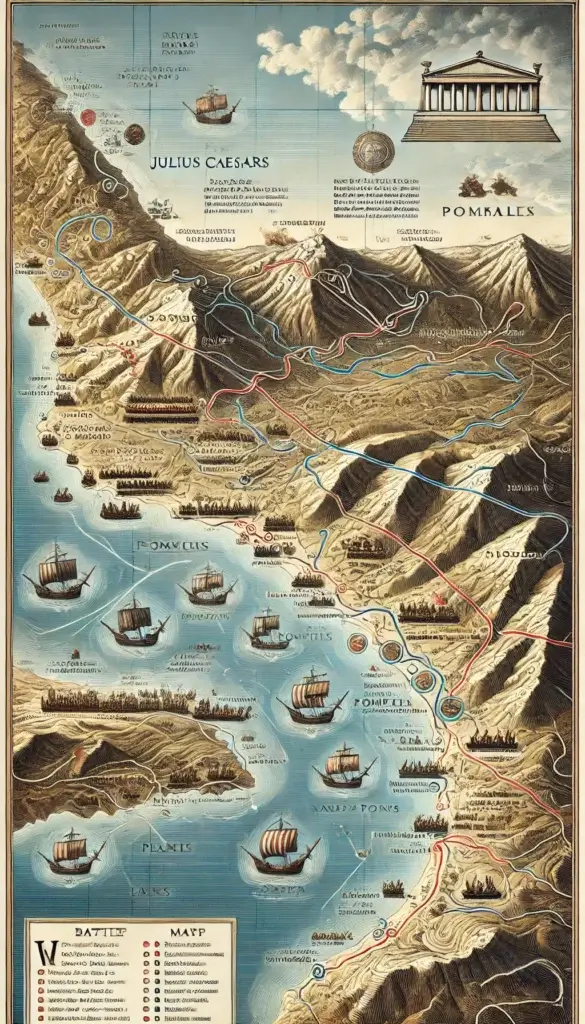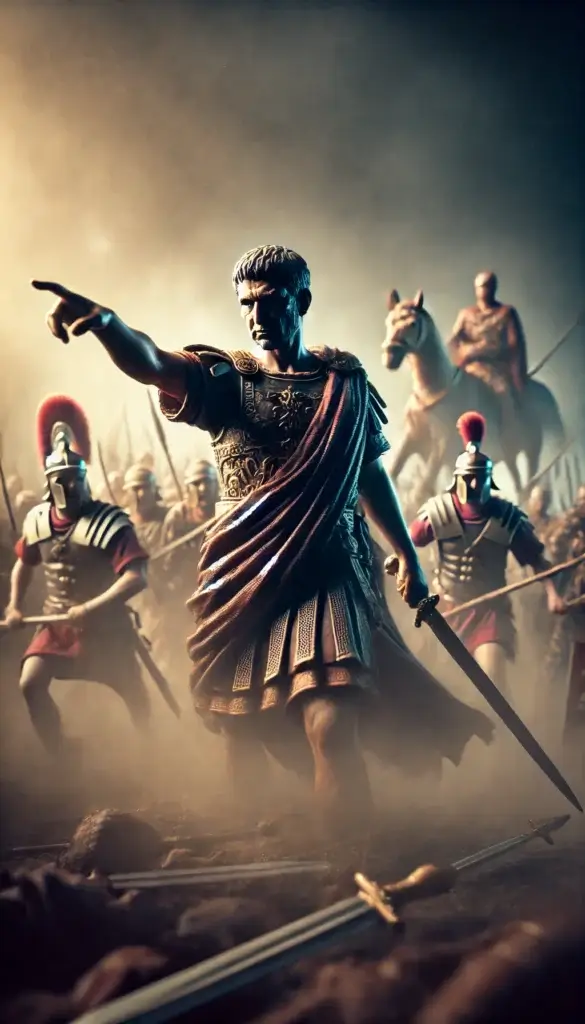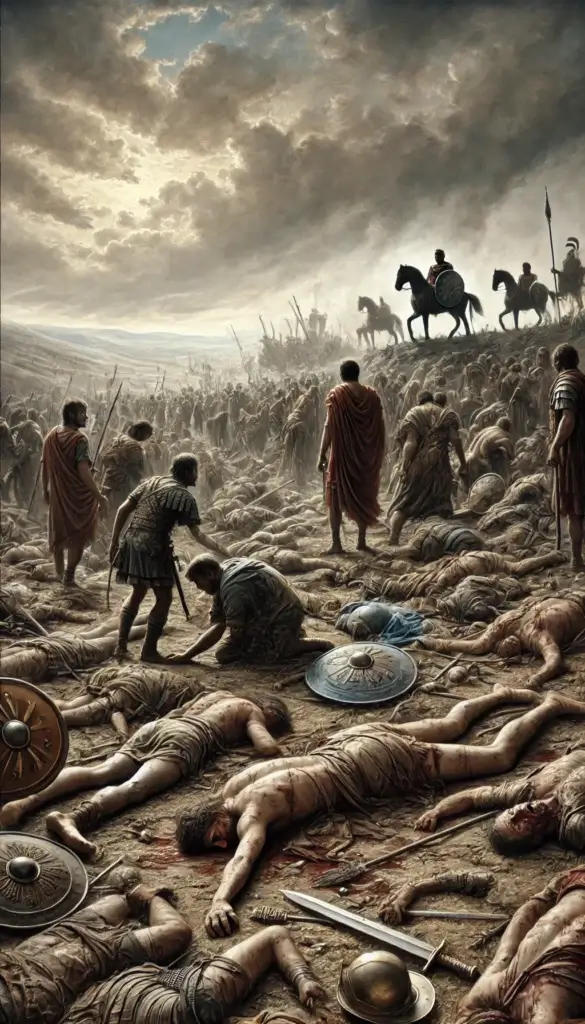
Introduction
The Battle of Pharsalus, fought on August 9, 48 BCE, was a defining moment in Roman history. It marked the climax of the civil war between Julius Caesar and Pompey the Great. This battle not only decided the fate of these two iconic leaders but also set the stage for the collapse of the Roman Republic and the rise of the Roman Empire. This article will explore the background, strategies, and impact of the Battle of Pharsalus.
The Road to Pharsalus: A Prelude to War
The Rise of Julius Caesar
Julius Caesar’s rise to power was marked by a combination of military prowess and political skill. Born in 100 BCE into a patrician family, he quickly became known as a brilliant general and shrewd politician. His conquest of Gaul, completed in 50 BCE, significantly expanded Rome’s territories. This success earned him immense wealth and the loyalty of his legions. However, Caesar’s growing influence alarmed many in the Roman Senate, particularly his former ally, Pompey the Great.
Pompey the Great: Rome’s Champion
Pompey was one of Rome’s most celebrated generals. He achieved numerous military victories across the Mediterranean. As a member of the First Triumvirate, alongside Caesar and Marcus Licinius Crassus, Pompey held significant influence over Roman politics. After Crassus’s death in 53 BCE, the alliance between Caesar and Pompey began to deteriorate. Pompey aligned himself with the Senate, which sought to curtail Caesar’s rising power.
The Breakdown of the First Triumvirate
The alliance between Caesar, Pompey, and Crassus was based on mutual convenience. It brought together three of Rome’s most powerful figures. However, Crassus’s death and the subsequent political maneuvering set Caesar and Pompey on a collision course. By 49 BCE, tensions had reached a boiling point. The Senate, now backing Pompey, ordered Caesar to disband his army and return to Rome. Caesar’s response was the famous crossing of the Rubicon River, a clear declaration of war against Pompey and the Senate.
The Roman Civil War Begins
Caesar’s crossing of the Rubicon in January 49 BCE plunged Rome into civil war. Pompey, who initially controlled the Senate and most of Rome’s military forces, retreated to Greece to gather his forces. Caesar, relentless in his pursuit, quickly advanced through Italy. He then crossed into Spain, where he swiftly defeated Pompey’s legions. By the summer of 48 BCE, Caesar had secured most of Italy and Spain, leaving Pompey with little choice but to make a stand in Greece.
The Build-Up to Pharsalus: Strategic Maneuvers
Pompey’s Strategy: A War of Attrition
Pompey’s strategy in Greece was to use his superior numbers and naval dominance to wear down Caesar’s forces. He commanded a larger army and had access to resources from the eastern provinces. Pompey planned to cut off Caesar’s supply lines, forcing him into a war of attrition. Pompey believed that time was on his side since Caesar’s army, though formidable, was far from home and dependent on securing new supplies.
Caesar’s Strategy: Speed and Surprise
Caesar relied on speed and surprise. His forces were outnumbered, but they were battle-hardened and fiercely loyal. Caesar knew that a prolonged conflict would favor Pompey, so he sought to bring the war to a swift conclusion. After crossing into Greece, Caesar launched a series of bold maneuvers aimed at forcing Pompey into a decisive battle. Despite several skirmishes, Pompey avoided a full-scale confrontation, hoping to weaken Caesar over time. However, Caesar’s relentless pursuit eventually cornered Pompey near Pharsalus.
The Camps at Pharsalus
By August 48 BCE, both armies had established camps near Pharsalus in central Greece. Pompey’s camp was on higher ground, giving him a strategic advantage. Caesar’s camp was on the plain below. The terrain was critical to the coming battle, with Pompey’s forces occupying a strong defensive position. Despite this, Caesar was determined to engage Pompey in battle, knowing that his only chance for victory lay in defeating Pompey’s army decisively.
The Battle of Pharsalus: A Clash of Titans

The Armies Face Off
On the morning of August 9, 48 BCE, the two armies prepared for battle. Pompey’s forces numbered around 45,000 infantry and 7,000 cavalry. In contrast, Caesar commanded 22,000 infantry and 1,000 cavalry. Pompey’s army was composed of Roman legions, allied troops, and auxiliary forces from the eastern provinces. Caesar’s army consisted of veteran legions, many of whom had fought with him in Gaul and Spain.
The Deployment of Forces
Pompey arranged his forces in a traditional Roman formation. His infantry was in the center, with his cavalry on the left flank. Pompey placed great emphasis on his cavalry, commanded by Titus Labienus, a former ally of Caesar. Pompey planned to use his cavalry to outflank and envelop Caesar’s smaller army. He believed that a crushing blow to Caesar’s right flank would break his forces.
Caesar, anticipating Pompey’s strategy, took several key steps to counter it. He placed his veteran legions on the right flank, instructing them to form a strong defensive position. Additionally, Caesar secretly positioned a group of 3,000 elite infantry behind his right flank, hidden from Pompey’s view. This Fourth Line was to be Caesar’s trump card, waiting to spring a surprise counterattack on Pompey’s cavalry.
The Battle Begins
The battle commenced with the usual exchange of missile fire. Both armies hurled javelins and projectiles at each other. Pompey’s forces remained stationary, hoping to lure Caesar into an attack. Caesar recognized the standoff and ordered his infantry to advance at a slow pace. This ensured they would not become exhausted before engaging Pompey’s forces. As Caesar’s legions closed in, Pompey’s cavalry began their assault on Caesar’s right flank. Much like the strategic financial innovations of the Knights Templar in medieval Europe, Caesar’s logistical acumen during the Battle of Pharsalus played a crucial role in his victory.
The Decisive Moment: The Fourth Line Strikes

As Pompey’s cavalry engaged Caesar’s right flank, they initially succeeded in pushing back Caesar’s cavalry. However, when they advanced to outflank Caesar’s forces, they were met with a surprise. Caesar’s hidden Fourth Line suddenly charged at the advancing cavalry, catching them off guard. The elite infantry, armed with javelins and short swords, quickly broke through Pompey’s cavalry, causing them to flee in disarray.
With Pompey’s cavalry routed, Caesar’s forces turned their attention to the now-exposed left flank of Pompey’s infantry. The disciplined and experienced legions pressed forward, creating gaps in Pompey’s lines. Pompey’s infantry, seeing their cavalry defeated and their flank exposed, began to falter. Sensing victory, Caesar ordered his entire line to advance, overwhelming Pompey’s forces.
The Collapse of Pompey’s Army
The battle quickly turned into a rout. Pompey, realizing the battle was lost, fled the battlefield. He left his army to face the onslaught of Caesar’s legions. Caesar’s forces showed no mercy, cutting down thousands of Pompey’s troops as they attempted to flee. By the end of the day, Pompey’s army had been decimated. Estimates suggest that up to 15,000 of his soldiers were killed, and another 24,000 were captured. Caesar’s losses were minimal in comparison, with only about 1,200 casualties.
The Aftermath: The End of Pompey and the Rise of Caesar
Pompey’s Flight and Death
After his defeat at Pharsalus, Pompey fled to Egypt. He sought refuge with the Ptolemaic dynasty. However, upon his arrival, agents of King Ptolemy XIII betrayed and assassinated him. Pompey’s death marked the end of the civil war’s most formidable opponent. It also cleared the path for Caesar’s unchallenged dominance. While Julius Caesar solidified his power through decisive military victories, leaders like Queen Boudica took a different approach, leading fierce rebellions against Roman rule.
Caesar’s Triumph and Consolidation of Power
With Pompey defeated, Caesar returned to Rome as the undisputed leader of the Roman Republic. Over the next few years, he pursued a series of political and social reforms aimed at consolidating his power and stabilizing the Republic. These reforms included the reorganization of the Senate, the introduction of the Julian calendar, and the expansion of Roman citizenship. However, Caesar’s growing authority and the perception that he aimed to establish a monarchy created tension among Rome’s elite.
The Assassination of Caesar

On March 15, 44 BCE, Caesar was assassinated by a group of senators led by Marcus Junius Brutus and Gaius Cassius Longinus. The assassination was motivated by fears that Caesar intended to crown himself king. Many believed this move would mark the end of the Republic. However, Caesar’s death did not restore the Republic. Instead, it plunged Rome into a new round of civil wars. These conflicts ultimately led to the rise of Caesar’s adopted heir, Octavian (later Augustus), as the first Roman emperor.
The Legacy of Pharsalus: The Fall of the Roman Republic
The Impact on Roman Politics
The Battle of Pharsalus was more than just a military victory; it marked a significant turning point in Roman politics. Caesar’s triumph at Pharsalus demonstrated the shifting power dynamics within the Republic. Military might increasingly overshadowed traditional republican values. The Senate, once the most powerful body in Rome, now found itself subservient to the ambitions of military leaders like Caesar. This shift in power marked the beginning of the end for the Roman Republic, as individual rulers who commanded theloyalty of the legions increasingly dominated Roman politics.
The Prelude to Empire
The consequences of Pharsalus reverberated throughout the Roman world. With Pompey’s death and Caesar’s consolidation of power, the republican institutions that had governed Rome for centuries began to erode. Caesar’s centralization of power, coupled with his growing control over the military and political life of Rome, laid the groundwork for the eventual rise of the Roman Empire. Although Caesar’s assassination temporarily halted this transformation, it did not prevent it. Instead, it accelerated the process, leading to further civil wars that culminated in the establishment of the Roman Empire under Augustus.
Military Lessons from Pharsalus
The Battle of Pharsalus is often studied for its military lessons. Caesar’s ability to outmaneuver a larger and better-positioned force showcased his tactical genius. His use of the hidden Fourth Line to counter Pompey’s cavalry was a masterstroke, demonstrating the importance of adaptability and surprise in warfare. Moreover, Caesar’s emphasis on the morale and loyalty of his troops played a crucial role in his success. Caesar’s legions, much like the fearsome Úlfhéðnar warriors of Viking lore, used a combination of disciplined tactics and psychological warfare to dominate their enemies. The Battle of Pharsalus serves as a reminder that leadership, strategy, and the psychological state of an army can be as decisive as numerical strength.
Cultural and Historical Significance
Pharsalus has left a lasting legacy in the cultural and historical memory of Rome. The battle has been immortalized in literature, art, and historical texts. Ancient historians such as Plutarch, Suetonius, and Appian provided detailed accounts of the battle, often highlighting Caesar’s brilliance and Pompey’s tragic fall. In the centuries that followed, Pharsalus became a symbol of the fall of the Roman Republic, representing the consequences of unchecked ambition and the fragility of political institutions.
Pharsalus has also influenced Western thought on leadership and governance. The conflict between Caesar and Pompey, two of Rome’s most capable leaders, serves as a case study in the dangers of political rivalry and the perils of civil war. It illustrates how internal conflict can lead to the downfall of even the most powerful states, a lesson that has resonated through history.
Pharsalus in Popular Culture
Depictions in Literature and Film
The Battle of Pharsalus has been depicted in numerous works of literature and film, often highlighting the drama and tragedy of the conflict. William Shakespeare’s play “Julius Caesar,” while focused on the events leading up to Caesar’s assassination, captures the tension and political intrigue that characterized the period. The battle itself is a backdrop to the larger narrative of power, betrayal, and the struggle for control over Rome.
In modern times, the battle has been portrayed in films and television series that explore the lives of Caesar and Pompey. These depictions often emphasize the personal rivalry between the two men, as well as the broader political implications of their conflict. The cinematic portrayal of Pharsalus usually focuses on the tactics used by Caesar and the psychological impact of the battle on both the soldiers and their commanders.
Interestingly, other historical figures like Mithridates VI also employed unconventional tactics, such as the use of mad honey for biochemical warfare.
The Battle as a Metaphor
Pharsalus has also been used as a metaphor in political and military discourse. The battle is often cited as an example of how strategic foresight and leadership can overcome seemingly insurmountable odds. In this context, Caesar’s victory at Pharsalus serves as a powerful illustration of the importance of adaptability, innovation, and the ability to inspire and lead troops in the most challenging circumstances.
Moreover, the battle is a metaphor for the collapse of political institutions in the face of personal ambition. Just as the Roman Republic fell victim to the ambitions of its leaders, Pharsalus is a reminder of how the concentration of power in the hands of a few can destabilize and ultimately destroy even the most enduring systems of governance.
Conclusion
The Battle of Pharsalus was a turning point in Roman history, signaling the end of the Roman Republic and the rise of a new political order that would eventually culminate in the Roman Empire. The conflict between Julius Caesar and Pompey the Great, two of Rome’s most formidable leaders, was emblematic of the larger struggle for power that characterized the late Republic.
Caesar’s victory at Pharsalus not only secured his position as the dominant figure in Roman politics but also demonstrated the transformative power of military leadership and strategy. The battle’s legacy continues to be felt today, offering lessons in leadership, governance, and the dangers of unchecked ambition.
Pharsalus serves as a crucial chapter in the history of Rome, a reminder of the complexities of power and the consequences of civil war. As we reflect on this epic clash, we gain a deeper understanding of the forces that shaped the ancient world and the enduring impact of these historical events on our own time.
